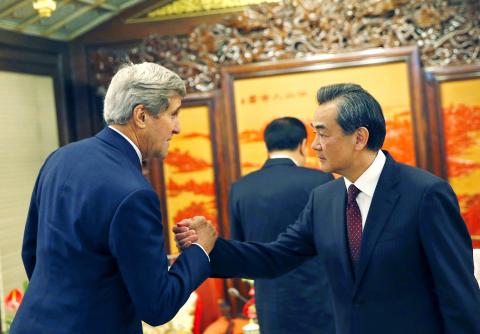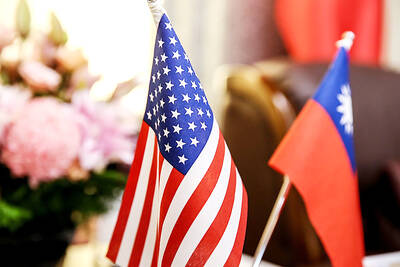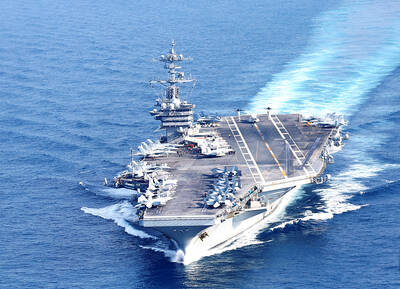US Secretary of State John Kerry and US Department of State officials yesterday met Chinese leaders, vowing a tough line over Beijing’s island-building in disputed waters.
The US is weighing sending warships and surveillance aircraft within 12 nautical miles (22.2km) — the normal territorial zone around natural land — of artificial islands that Beijing is building in the South China Sea.
Such a move could lead to a standoff in an area home to vital global shipping lanes and believed to be rich in oil and gas deposits.

Photo: AFP
The world’s top two economies have significant commercial ties and Chinese President Xi Jinping (習近平) is due to pay a state visit to the US in September.
However, China’s ambitions for a place on the world’s political stage commensurate with its economic role have seen it cross the US in multiple fields, and the two have long-running disputes over issues ranging from trade to cyberespionage to human rights.
Kerry’s first meeting was with Chinese Minister of Foreign Affairs Wang Yi (王毅), and he met senior political and military leaders later.
Pentagon officials last week revealed that China is building artificial islands on South China Sea coral reefs — which are also claimed by Taiwan — at an unprecedented pace, in a land reclamation effort dubbed a “great wall of sand” by one US commander.
The rapid construction amounts to 800 hectares, with 75 percent of the total created in the past five months alone.
Department officials said ahead of the talks in Beijing that Kerry would “reinforce ... the very negative consequences on China’s image, on China’s relationship with its neighbors, on regional stability, and potentially on the US-China relationship” of Beijing’s activities in the sea.
Beijing claims nearly all of the South China Sea, even waters close to the coasts of other littoral states, on the basis of a segmented line dating back to Chinese maps of the 1940s, known as the “nine-dash line.”
One official said Kerry would “leave his Chinese interlocutors in absolutely no doubt that the United States remains committed to maintain freedom of navigation.”
“That’s a principle that we are determined to uphold,” the official added.
US officials say Washington needs to send a clear signal about China’s dredging activities around the Spratly Islands (Nansha Islands, 南沙群島) and other disputed territories, although they want to calibrate any military operation to avoid triggering a crisis.
They also stress that according to the UN Convention on the Law of the Sea, only natural land masses create a territorial claim, not artificial islands.
“You can’t build sovereignty,” an official said.
However, the US has never ratified the convention itself.
The US is China’s second-biggest trading partner after the EU, with trade between the two worth US$555 billion last year, according to Chinese customs figures.
Beijing is the heavily-indebted US government’s biggest foreign creditor, figures from Washington showed on Friday, reclaiming top spot from Japan with more than US$1.26 trillion in Treasury bonds.
China defends the island-building as taking place within its own territory and intended to enhance its ability to carry out international obligations such as search and rescue.
In a commentary ahead of yesterday’s talks, China’s Xinhua news agency said the US is guilty of “thinly veiled hypocrisy.”
“The United States is not a party in the South China Sea disputes, which are between China and other claimants and should be handled by those directly involved,” it said.
“Washington has no valid grounds whatsoever to point an accusing finger at Beijing over the South China Sea. Instead, it needs to look at itself in the mirror,” it said, accusing the US of seeking “a pretext to maintain its hegemonic presence in the region.”
The US is in the process of a foreign policy “pivot” toward Asia.

CROSS-STRAIT COLLABORATION: The new KMT chairwoman expressed interest in meeting the Chinese president from the start, but she’ll have to pay to get in Beijing allegedly agreed to let Chinese Nationalist Party (KMT) Chairwoman Cheng Li-wun (鄭麗文) meet with Chinese President Xi Jinping (習近平) around the Lunar New Year holiday next year on three conditions, including that the KMT block Taiwan’s arms purchases, a source said yesterday. Cheng has expressed interest in meeting Xi since she won the KMT’s chairmanship election in October. A source, speaking on condition of anonymity, said a consensus on a meeting was allegedly reached after two KMT vice chairmen visited China’s Taiwan Affairs Office Director Song Tao (宋濤) in China last month. Beijing allegedly gave the KMT three conditions it had to

STAYING ALERT: China this week deployed its largest maritime show of force to date in the region, prompting concern in Taipei and Tokyo, which Beijing has brushed off Deterring conflict over Taiwan is a priority, the White House said in its National Security Strategy published yesterday, which also called on Japan and South Korea to increase their defense spending to help protect the first island chain. Taiwan is strategically positioned between Northeast and Southeast Asia, and provides direct access to the second island chain, with one-third of global shipping passing through the South China Sea, the report said. Given the implications for the US economy, along with Taiwan’s dominance in semiconductors, “deterring a conflict over Taiwan, ideally by preserving military overmatch, is a priority,” it said. However, the strategy also reiterated

‘BALANCE OF POWER’: Hegseth said that the US did not want to ‘strangle’ China, but to ensure that none of Washington’s allies would be vulnerable to military aggression Washington has no intention of changing the “status quo” in the Taiwan Strait, US Secretary of Defense Pete Hegseth said on Saturday, adding that one of the US military’s main priorities is to deter China “through strength, not through confrontation.” Speaking at the annual Reagan National Defense Forum in Simi Valley, California, Hegseth outlined the US Department of Defense’s priorities under US President Donald Trump. “First, defending the US homeland and our hemisphere. Second, deterring China through strength, not confrontation. Third, increased burden sharing for us, allies and partners. And fourth, supercharging the US defense industrial base,” he said. US-China relations under

The Chien Feng IV (勁蜂, Mighty Hornet) loitering munition is on track to enter flight tests next month in connection with potential adoption by Taiwanese and US armed forces, a government source said yesterday. The kamikaze drone, which boasts a range of 1,000km, debuted at the Taipei Aerospace and Defense Technology Exhibition in September, the official said on condition of anonymity. The Chungshan Institute of Science and Technology and US-based Kratos Defense jointly developed the platform by leveraging the engine and airframe of the latter’s MQM-178 Firejet target drone, they said. The uncrewed aerial vehicle is designed to utilize an artificial intelligence computer